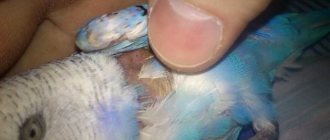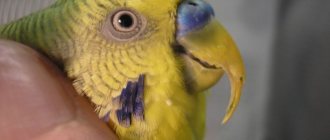Pets not only bring joy to their owners, but sometimes they cause allergies. An allergy to parrots causes a lot of trouble for adults, but children suffer especially, for whom they get birds. Before buying a parrot, it is worth thinking about the following questions: what can cause an allergic reaction, how it manifests itself and what are its consequences. How to predict the appearance of an allergy, and whether it is possible to get rid of it - we will look at all the nuances in this article.
general information
An allergic reaction is a response of the immune system to harmful substances. In the case of birds, this substance is a special protein. If the immune system is strong and there is no hereditary predisposition, the body adapts and the health does not deteriorate.
Attention! The trigger is sometimes a decrease in immunity. Even if a person has previously interacted with parrots without problems, he may subsequently develop intolerance.
The tricky part about parrot allergy is how it manifests itself. Allergen components accumulate in the body, and then signs of intolerance come to the fore:
- swelling;
- profuse lacrimation;
- mucus from the nose;
- sneezing.
This may happen after a few days or months. Particularly sensitive people cannot tolerate even the slightest allergens. While in a room with a parrot, they inhale particles of the irritant, and the reaction develops very quickly.
Allergy symptoms
The following manifestations indicate the occurrence of an allergic reaction:
- Prolonged, profuse runny nose.
- Excessive lacrimation, itching in the eye area.
- Sneezing attacks, itchy nose.
- Itchy skin rashes.
- Labored breathing.
If you experience one or more of the above symptoms, be sure to consult an allergist. Only a specialist will be able to prescribe the correct test to determine allergies and effective treatment of the disease.
What is an allergen
The allergic reaction is caused by a protein found in the parrot's saliva and excrement. When a bird grooms itself, cleans and arranges its feathers, it moistens them with saliva. Fuzz and feathers fly out of the parrot's cage. The smallest particles of secretions and epidermis are carried through the air, settle on surrounding objects, and then the person inhales them.
Another possible cause of allergies is microscopic organisms and insects that parasitize the parrot’s body. These could be ticks, bedbugs, fleas. By shaking and scratching, the parrot spreads the waste products of parasites around itself. In addition, birdseed is sometimes an allergen.
The risk of intolerance depends on the type of parrot: the greatest danger comes from grays, macaws, and cockatiels. Less commonly, people are allergic to budgies and lovebirds. Most likely, this is due to the small size of the pets, and, accordingly, the smaller surface area of the plumage. In addition, in small parrots the allergy-provoking protein is less aggressive.
What are the consequences of allergies in children?
Favorite parrots can become a source of serious danger for a child! Chronic household allergies often develop into alveolitis, which in turn leads to pulmonary failure. Even after complete recovery, shortness of breath and cough remain with the patient.
The second most dangerous consequence is Quincke's edema. This is a rapidly developing allergic reaction with a fatal outcome.
If measures are not taken, the child may simply suffocate.
Symptoms
Since the allergen enters the body through the respiratory tract, the initial symptoms are associated with respiratory manifestations:
- runny nose;
- sinus congestion;
- mucous discharge from the nose;
- sneezing;
- dry cough;
- swelling and itching of the mucous membranes.
Main symptoms: redness of the eyeballs and conjunctiva, photophobia, profuse tears. Dermatitis and various rashes form on the skin. If children are allergic to parrots, their temperature may rise and their health may worsen, as if they had a cold. There are difficulties with breathing. In severe cases, the sense of smell disappears, headaches and nosebleeds begin. There is a risk of bronchial asthma.
An exacerbation of symptoms does not occur immediately after acquiring a parrot, but with regular communication with the pet. This is facilitated by the necessary activities: cleaning the cage, training the bird. The sensitivity of the human body increases during the molting of a parrot.
Attention! If a person has a tendency to allergies, he can get it through close contact: stroking a parrot and being at close range with it. Symptoms can appear even in those who simply enter the room where the parrot lives.
Causes
Organic compounds that make up dust enter the apartment from the street, from our shoes and clothes, and from pets. Street dust is plant pollen, particles of earth, gravel, asphalt, microparticles that penetrate windows with wind and smoke. Household air pollutants include cellulose from book pages and wallpaper, and mold fungi. Dust mites living in furniture and bedding are strong allergens. They feed on human epidermal cells, secreting special enzymes to break them down, which provoke an allergic reaction.
Options for allergic reactions
Allergies to parrots can manifest themselves in different ways. People have individual reactions to allergens: one suffers from skin rashes, another suffers from a runny nose, another is haunted by itching and a feeling of sand in the eyes. Often several signs appear simultaneously or alternately. The most severe complication is alveolitis, the extreme stage of intolerance.
Skin rashes
With allergies, changes in the skin on the face or hands are observed. The rash occurs in the form of spots, papules, and blisters. Individual pinpoint redness on the skin can merge into large areas. Characteristic features of allergies include pinkish elevations on the skin and blisters filled with clear liquid. The number and volume of rashes increases with scratching. In this case, a secondary infection may occur, and purulent structures will appear.
Conjunctivitis
People who are familiar with bird allergies first-hand often experience its manifestations. This may be irritation of the mucous membranes of the eyes. When an allergen gets into the eyes, a reaction develops immediately:
- eyelids swell;
- the conjunctiva turns red;
- severe itching occurs;
- blood vessels burst from friction in the eyes;
- tears flow for no reason;
- a feeling of a foreign body is created.
If a person does not restrain himself and often rubs his eyes, he risks getting an infection. In this case, purulent crusts accumulate in the corners of the eyes.
Rhinitis
Allergic rhinitis is a runny nose that occurs when exposed to allergens. It can be chronic if there is constant contact between the parrot and a person susceptible to allergies. Symptoms persist for four weeks or more. Allergic rhinitis causes severe discomfort and reduces quality of life. Without treatment, the disease can develop into bronchial asthma. An acute form of rhinitis occurs if a person does not keep birds at home, but, for example, visited a pet store. After a few days, the symptoms disappear.
Alveolitis
A mild allergy to birds does not cause any particular harm to health, but only if the attacks are stopped in a timely manner. However, there is a possibility of complications. Alveolitis is a dangerous disease that develops under the guise of rhinitis and conjunctivitis. These are seals on the alveoli that prevent the free circulation of air in a person’s lungs.
Alveolitis is characterized by three stages:
- slow;
- chronic;
- spicy.
Chronic alveolitis is an alternation of calm periods with attacks of exacerbation.
The mechanism of the disease is that allergen molecules are not retained by the villi in the nose, but enter the lungs with the flow of inhaled air. The disease is accompanied by symptoms similar to those that occur with bacterial pneumonia:
- persistent cough;
- wheezing;
- headache;
- attacks of shortness of breath and suffocation;
- fever;
- muscle spasms.
Gradually, the alveolar tissue is replaced by connective tissue, and this process is irreversible. Complete relief from alveolitis is possible, but only if contact with the allergen is avoided.
What can a household allergy lead to?
With constant irritation of the skin by allergens, eczema can develop, and allergic inflammation of the mucous membrane of the eyes can aggravate the inflammation of the cornea and other tissues of the eyeball.
Due to constant irritation by dust allergens, the nasal mucosa thickens, polypous growths occur and external respiration is impaired. In children, this can lead to academic failure and even mental retardation.
Bronchial asthma can be complicated by an asthmatic condition - this is the name for an attack of suffocation as a result of prolonged narrowing of the bronchi in response to the intake of an allergen.
Anaphylaxis, a violent allergic reaction of the body, also poses a threat to life. Of course, we should not forget that dust is not only an allergen, but also a substance that provokes malignant processes - for example, lung cancer. Scientists believe that the high incidence of this disease is associated not only with the large number of smokers, but also with the degree of air pollution from exhaust gases, industrial waste and substances formed during the decomposition of garbage. Remember, dust is serious!
Treatment
The treatment method for each patient is selected individually, depending on the severity of the disease and age. Treatment of parrot allergies in adults is characterized by the use of strong drugs. On the contrary, serious medications can cause a negative reaction in the child’s body.
Important point! Complicated allergies require the patient to be admitted to a hospital, where he will undergo inhalations, breathing exercises, and chest massage.
Drugs
To make you feel better, allergy sufferers should take antihistamines:
- Suprastin;
- Loratadine;
- Tavegil;
- Cetirizine;
- Hifenadine;
- Diazolin.
You can relieve inflammation from the eyes using Okumetil drops. Skin rashes are removed with special ointments like Fenistil gel or Skin-Cap cream. A runny nose can be treated with sprays and drops: Xylometazoline, Fenistil. Part of the complex treatment includes hormonal medications prescribed by an allergist.
Additional measures
At the first suspicion that you or your children are developing an allergy to birds, it is necessary to eliminate the source of the disease. The parrot will have to be given or sold to someone. If you are in doubt and value your pet very much, temporarily place it in a shelter. Once the cause of the disease has been established, a final decision can be made.
Having stopped communicating with the bird, you need to remove all the attributes used to keep it and sanitize the apartment:
- wash curtains, bedding, bedspreads;
- shake out mattresses, blankets, pillows;
- thoroughly clean covers and upholstered furniture;
- wash and dry carpets and rugs;
- wipe all surfaces with liquid cleaning product;
- ventilate the rooms.
It is advisable that people who do not have allergies do the cleaning. The patient should temporarily move to another apartment.
Where does dust come from?
Even in the home of the most pedantic housewife, who keeps her home in perfect order, there is house dust. Few people know, but approximately 30% of dust is formed in the process of human activity - these are particles of human skin and animal hair. 70% of dust flies into our homes from afar. Scientists believe that the main sources of dust on the planet are the Sahara Desert and the Japanese Sakurajima volcano.
Unbelievable but true…
Every year, about 20 kilograms of dust settles in an ordinary two-room apartment!
Dust can be domestic, that is, associated with human life, or industrial. Dust particles differ in composition and origin, but cause the same symptoms on the skin and mucous membranes in allergy sufferers.
Effective treatment of dust allergies in children and adults these days necessarily includes removing the allergen from the body with the help of a modern and safe enterosorbent - we are talking about the popular drug Enterosgel. It has been repeatedly proven that enterosorption is an excellent way to stop contact with an allergen, and this, as you know, is the very first thing to start treating allergies. But let’s not get ahead of ourselves and figure out where allergies actually come from.
What is the danger for children
Parrot allergies are detected faster in children than in adults. Children's immunity is unstable: the allergen instantly spreads throughout the body. The protein immediately enters the lower parts of the lungs, and an acute form of allergy manifests itself. Respiratory function is impaired, and there is a lack of oxygen.
The child begins to feel chills, shortness of breath appears, and then he feels weak and quickly gets tired. The limbs become bluish due to oxygen deprivation. Lung volume is reduced, and this is fraught with serious consequences. Treatment begins immediately. You may even need surgery and a long recovery.
Diagnostics and tests
Diagnosis of parrot allergies is carried out in several ways. If a certain type of allergic reaction is suspected, then special allergen tests .
In the absence of specific facts indicating the occurrence of health problems after contact with the bird, the child will have to undergo a comprehensive examination and undergo several types of tests.
procedures can be used for diagnosis :
- skin tests;
- microscopic examination of sputum;
- general blood analysis;
- PCR method;
- blood chemistry.
How to find out if you are allergic to parrots
If any family member has allergies of any kind, progressive pathology can lead to intolerance to contact with parrots. To avoid having to part with your beloved pet, you should find out in advance whether there may be an allergy to birds in your family.
Use every opportunity to communicate with a parrot: go to visit friends who have birds, visit petting zoos, take your child to the living corners of schools and kindergartens. One visit is not enough - it is advisable to contact the bird for several weeks, this is the only way to find out if you have allergies.
On a note! You can take an active part in caring for your pet, even cleaning its cage. Be attentive to your well-being: deterioration in health during this period of time allows us to draw a conclusion about individual intolerance.
If there are reasons for an examination, you should not neglect it. It is necessary to undergo special tests for allergens. In addition, other methods are used: blood test, sputum examination. If the possibility of an allergic reaction is detected, it is recommended not to purchase a parrot. Even if your pet lives in a separate room, there is no guarantee that you or your children will not develop allergies.
If the test results show that the body is tolerant to the antigen protein, you can get an exotic bird. It is necessary to pay special attention to the prevention of the development of allergies: regularly remove garbage, droppings and loose fluff, frequently ventilate the room and wash the floor. Allergy to birds is one of the most difficult to treat diseases, so you need to assess all the risks before buying a bright, sociable parrot.
Should I get rid of birds in my house?
A child's contact with parrots or being in the same room with them if they have allergies is contraindicated . It is recommended to test for an allergic reaction in advance before purchasing an exotic bird.
If the parrot is already present in the house, then it is better to give it to relatives or find other ways to prevent it from being near the child.
Objects that were in the room where the cage stood must be thoroughly disinfected to eliminate the presence of allergens on them.
Foods and additives that cause allergies
Doctors Sidorovich and Luss write that “almost any food product can act as an allergen and cause the development of food allergies. However, the most pronounced sensitizing properties are in products of protein origin containing animal and vegetable proteins” (Sidorovich O. I., Luss L. V., 2021, p. 141). The table shows the most common allergens in food:
| Plant food | Raspberries, strawberries, wild strawberries, black currants, blackberries, pineapple, melon, persimmon, pomegranate, citrus fruits, chocolate, tomatoes, nuts, honey, mushrooms, wheat, soybeans, carrots |
| Animal food | Milk, eggs, fish, crustaceans and seafood, cold processed chicken |
| Supplements | Pesticide residues and agricultural fertilizers in plant foods. Dyes (especially tartrazine, erythrosine, sodium nitrite), flavorings (glutamates), preservatives (benzoates, benzoic acid, sulfites), enzymes, thickeners, emulsifiers, bacteriostatics, flavor enhancers (monosodium glutamate), etc. |
Note that allergen additives provoke so-called false reactions, or pseudo-allergies. In this case, food antigens can act without the participation of allergic antibodies on target cells or activate certain biological systems; they are not based on immune reactions.
An increase in the level of histamine in the blood may not be associated with a true allergy, but with the consumption of foods containing it in large quantities: fermented cheeses, sauerkraut, dried ham, canned food, spinach.











